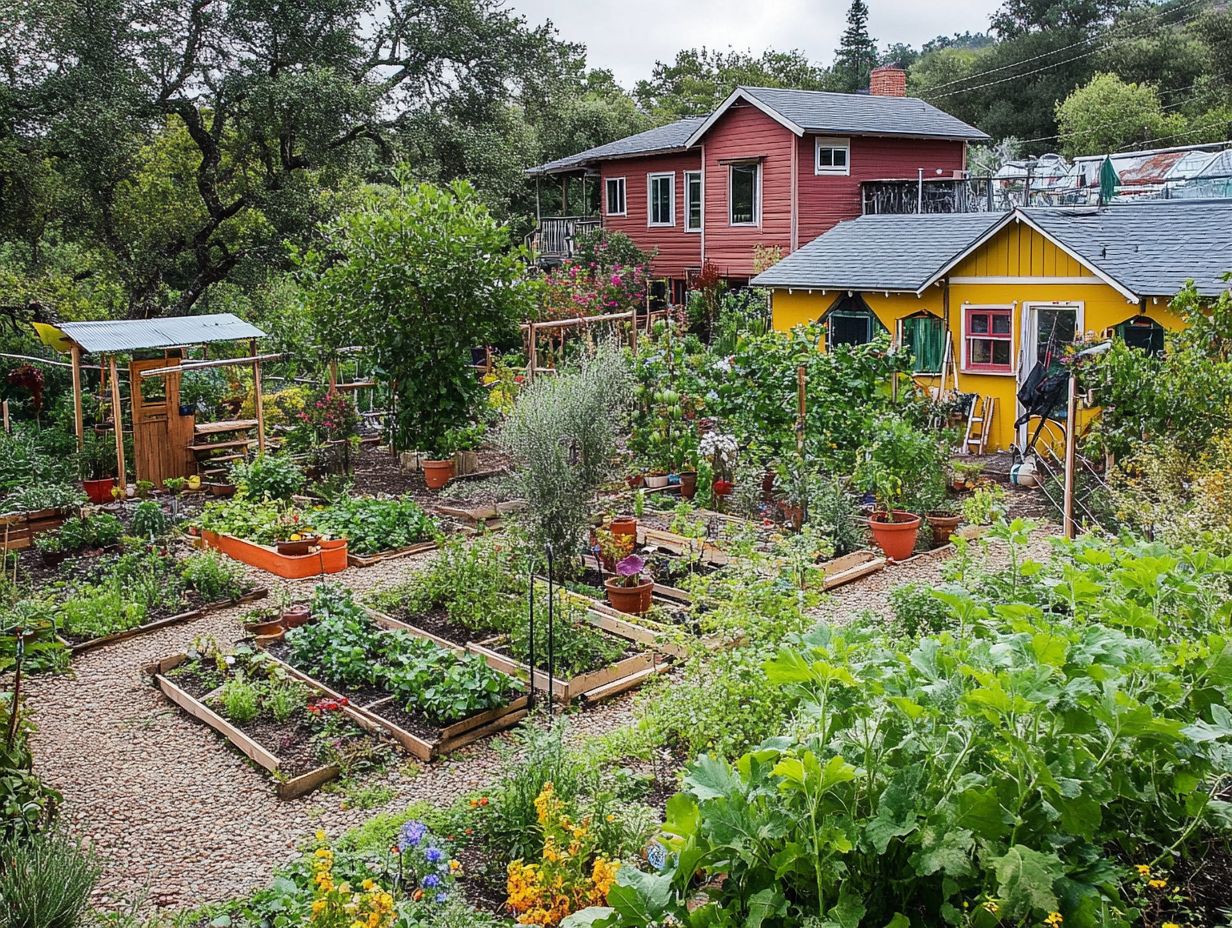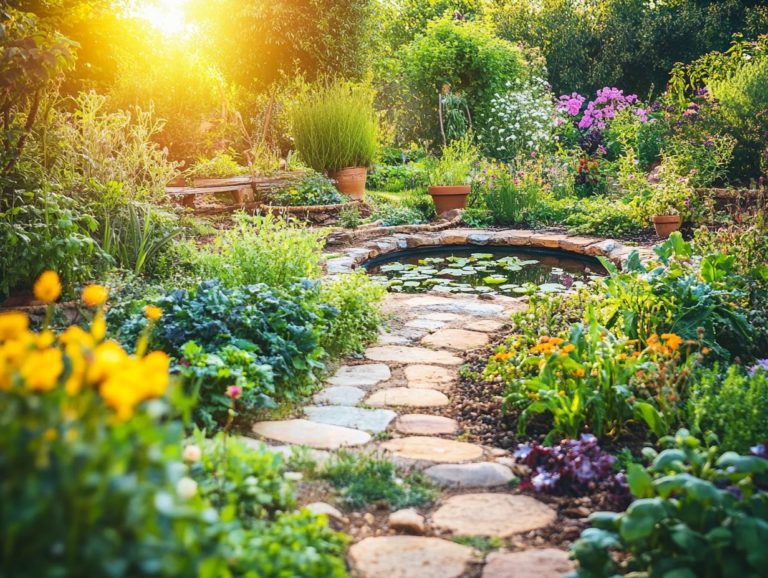The Interconnectedness of Permaculture Design Elements
Permaculture design presents a holistic approach to cultivating sustainable environments by emphasizing the interconnectedness of natural systems and the multifunctional elements that contribute to a thriving ecosystem.
This article delves into the core principles of permaculture. You will discover how various elements work in harmony to create resilient, self-sustaining ecosystems. Real-life case studies and practical strategies will help you implement these concepts in your own space, including water design and energy flow optimization.
Together, we ll uncover the myriad benefits of interconnected permaculture design not just for the environment, but also for our communities. We will address both needs and yields effectively.
Join us on this exciting journey toward a healthier planet and embrace the transformative potential of permaculture.
Contents
- Key Takeaways:
- The Basics of Permaculture Design
- Interconnectedness in Permaculture
- Designing for Resilience
- Examples of Interconnected Permaculture Elements
- Implementing Permaculture Design in Your Own Space
- Practical Tips and Strategies
- Benefits of Interconnected Permaculture Design
- Frequently Asked Questions
- What does it mean for permaculture elements to be interconnected?
- How is the interconnectedness of permaculture design elements important?
- Can you provide an example of the interconnectedness of permaculture design elements?
- How does the interconnectedness of permaculture design elements benefit the environment?
- What happens if one element of a permaculture system, such as the structural placement of functional trees, is disrupted?
- How can one promote the interconnectedness of permaculture design elements through urban garden design and climate control strategies by utilizing observation techniques?
Key Takeaways:

- Permaculture design involves understanding and utilizing the interconnectedness of various elements to create a sustainable and resilient system.
- By designing for resilience, permaculture systems can become self-sustaining and have a positive environmental and social impact.
- Examples and case studies demonstrate the effectiveness of interconnected permaculture elements. Practical tips can help individuals implement these design principles in their own space.
The Basics of Permaculture Design
Permaculture design represents a sophisticated, holistic approach to crafting sustainable ecosystems that emulate the intricacies of the natural world.
By analyzing how different elements in nature work together, you can gain a deeper understanding of the diverse elements and their interrelationships.
This knowledge gives you the power to develop effective permaculture design strategies that not only meet community needs but also elevate food production and the variety of plants and animals.
Ultimately, this methodology aims to create resilient designs that facilitate energy flow and enhance the interconnectedness of living systems. This fosters a thriving ecosystem for all.
Defining Permaculture and its Principles
Permaculture is more than just a buzzword; it s an ethical design system that seamlessly integrates agricultural practices with sustainable living. It adheres to core principles that champion ecological sustainability.
By closely observing natural systems, you can craft your designs to mirror the way ecosystems function organically. This approach encourages biodiversity. A mix of plants and animals, such as chickens and willow trees, can lead to richer soils and more robust ecosystems.
Take companion planting, for example an idea popularized by luminaries like Bill Mollison and David Holmgren. It allows you to boost yields while cutting down on the need for artificial inputs.
Techniques like composting and mulching show how you can transform waste into a resource. Enriching the soil with vital nutrients elevates productivity and fosters a profound connection between you and the land you nurture.
Interconnectedness in Permaculture
Let’s explore how everything in a permaculture system works together like a well-oiled machine. Interconnectedness in permaculture highlights the intricate relationships among the various elements, including the role of community in permaculture design.
By understanding these connections, you can appreciate how they enhance ecological balance and optimize energy flow. This creates a harmonious and sustainable environment.
Take the first step today! Start designing your permaculture garden and witness the difference it can make.
How Different Elements Work Together
In permaculture, you’ll find that various elements synergize through techniques like companion planting (planting two or more types of plants together to enhance growth) and strategic structural placement, as well as understanding the significance of water in permaculture design, elevating the overall efficiency and resilience of the system.
Consider the integration of nitrogen-fixing plants, such as legumes, into your garden. Not only do they enrich the soil, but they also support nearby crops by boosting their growth, ultimately fostering a more vibrant ecosystem.
The placement of swales (shallow ditches that manage water flow) can effectively direct water to the roots of trees and shrubs, minimizing erosion while enhancing moisture retention. This creates a dynamic cycle of energy; for instance, fallen leaves from trees decompose, returning essential nutrients to the soil, which, in turn, nourishes the plants.
Embracing these practices creates a lively garden, cultivating a strong model of sustainability, promoting biodiversity that benefits both the flora and fauna in your garden.
Designing for Resilience

Designing for resilience in permaculture means crafting systems that take care of themselves and gracefully adapt to changing conditions. By reducing waste and increasing harvests, you can achieve this through deliberate and thoughtful permaculture practices.
Creating a Self-Sustaining System
Creating a self-sustaining system in permaculture hinges on practical techniques like composting and using organic mulch to enhance soil health and fertility.
These methods not only cultivate healthier soil but also foster a balanced ecosystem that flourishes in harmony with nature s rhythms. By embracing composting techniques, you can recycle kitchen scraps and yard waste, transforming them into nutrient-rich additions for your garden.
Understanding the role of organic mulch whether it s straw, wood chips, or another natural material offers valuable protection for your soil. It retains moisture, suppresses weeds, and gradually decomposes to enrich the ground beneath.
To truly build a successful self-sustaining system, consider cultivating a diverse array of plant species to attract beneficial insects, creating a thriving environment that supports both productivity and sustainability.
Examples of Interconnected Permaculture Elements
You can observe real-life applications of interconnected permaculture elements through various case studies that highlight functional trees, diverse yields, and their significant contributions to overall biodiversity, including the top 5 principles for effective permaculture design.
These examples provide clear proof of how these food growing systems work harmoniously together, creating a thriving ecosystem.
Case Studies and Real-Life Applications
Case studies of successful permaculture gardens reveal how your thoughtful design can meet community needs effectively while enhancing food production and ecological health.
These gardens often showcase multi-layered plant systems that include perennial fruits, vegetables, and medicinal herbs, creating a self-sustaining ecosystem. In one remarkable instance, a community in the Pacific Northwest transformed a vacant lot into a vibrant permaculture space. They cleverly incorporated swales to manage water flow and employed companion planting techniques to maximize yields. This design not only diversified the variety of crops but also fostered a sense of community, with neighbors uniting for workshops and harvest festivals.
An urban permaculture garden in a densely populated area made use of vertical gardening techniques, enabling residents to grow food in limited space while simultaneously enhancing local biodiversity. These innovative examples show that smart design creates more than just food it builds connections and encourages care for the environment.
Implementing Permaculture Design in Your Own Space
Implementing permaculture design in your own space requires a thoughtful approach, blending practical tips and strategies that are finely tuned to your unique environment.
Whether you re working with a sprawling rural plot or a cozy urban garden, the possibilities are as diverse as your surroundings.
Practical Tips and Strategies

Practical tips and strategies for implementing permaculture design start with deepening your plant knowledge, honing your observation techniques, and applying effective design strategies.
As you embark on your permaculture journey, understanding local ecosystems becomes paramount. This involves conducting thorough observations of your surrounding environment. These observations allow you to gain valuable insights into native plants and the interactions of local wildlife.
Choosing the right plants that flourish in your specific climate, soil types, and sunlight exposure will set you up for a thriving garden.
By adopting efficient permaculture practices like companion planting, crop rotation (changing the types of crops grown in a specific area over time), and using natural pest deterrents you can unlock the full potential of your garden by enhancing its sustainability and productivity. With these practical steps, even novice gardeners like yourself can create flourishing environments that beautifully embody permaculture principles.
Benefits of Interconnected Permaculture Design
The advantages of interconnected permaculture design reach far beyond mere food production; they encompass profound environmental and social impacts, as detailed in understanding the permaculture design process.
This approach not only fosters permaculture ethics but also champions ecological sustainability, creating a complete system that benefits both the planet and its inhabitants.
Environmental and Social Impact
The environmental and social impact of interconnected permaculture designs can be truly remarkable, enhancing biodiversity, conserving resources, and meeting the needs of communities. To understand more about this approach, explore the essential elements of permaculture.
Consider a small village in Brazil, a country rich in biodiversity. The introduction of a permaculture system, a central theme in sustainable ecosystems, resulted in a thriving micro-ecosystem that supports a variety of plant and animal species, essential for maintaining ecological harmony. This significantly boosted local biodiversity.
By integrating fruit trees, native plants, and livestock in the same space, residents not only bolstered their food security, which is a key aspect of permaculture principles, but also deepened community connections as neighbors collaborated to nurture this vibrant living network.
In Australia, known for its diverse ecosystems, a similar permaculture initiative showcased improved soil health, achieved through composting techniques, and reduced water usage, optimized through efficient permaculture design. This illustrates how holistic approaches can tackle environmental challenges while fostering a sense of shared responsibility among community members.
Frequently Asked Questions
What does it mean for permaculture elements to be interconnected?
The interconnectedness of permaculture design elements refers to the understanding that all elements in a permaculture system are connected and rely on each other to function effectively. To learn more about this, check out the essential elements for a permaculture design.
How is the interconnectedness of permaculture design elements important?

The interconnectedness of permaculture design elements highlights the importance of considering all aspects of a system, rather than focusing on individual elements. This approach, rooted in understanding permaculture design principles, helps to create a more sustainable and resilient system.
Can you provide an example of the interconnectedness of permaculture design elements?
Sure! In a permaculture garden, the placement of plants and the use of companion planting techniques are all interconnected and contribute to the overall health and productivity of the garden.
How does the interconnectedness of permaculture design elements benefit the environment?
By considering the interconnectedness of permaculture design elements, we can create systems that work in harmony with nature, minimizing negative impacts and promoting biodiversity and ecosystem health. This approach highlights the power of community in permaculture design.
Act now to start your permaculture journey!
What happens if one element of a permaculture system, such as the structural placement of functional trees, is disrupted?
If one element of a permaculture system is disrupted, it can affect the entire system. Understanding permaculture design for sustainability is crucial for effective design and how these elements connect.
How can one promote the interconnectedness of permaculture design elements through urban garden design and climate control strategies by utilizing observation techniques?
To promote interconnectedness, observe how each element relates to others. Techniques like zoning (organizing elements based on their needs) and stacking (placing elements in layers) help in continuous evaluation and adjustment.






